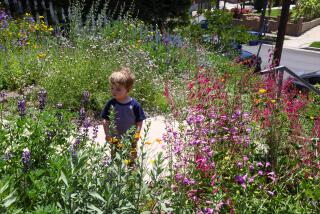Roses: The flowers of romance : are among the thirstiest in your garden. But now that it’s the season for pruning, planting and spraying, there are ways of making every drop count.
- Share via
We are in the middle of the rose season, and people are busy with their roses despite the drought. This, of course, is not when roses bloom, though a few blossoms may still be clinging to yellowing, unpruned bushes.
This is the time to plant, prune, spray and, in other ways, prepare roses for the seasons ahead. Gathered here are some timely tips.
Be warned that roses are thirsty plants. Since water rationing is predicted, you must figure them into your water budget. If they are to get the water they need, it must be saved elsewhere. One Southern California rose authority suggests that roses need two to five gallons of water every two days in well-drained, loamy soils.
It can be argued that they are worth the water, as the roses in Ivy Reid’s garden demonstrate. Reid is a garden designer, operating her own business called Ivy’s Garden. Her roses, growing in the coastal climate of Pacific Palisades, bloom all spring, summer and autumn.
Use “island beds.” Grouping roses and other flowers together in their own bed, as Reid has done, might be one way of saving water. Should push come to shove, other less thirsty or less desirable plants can slide.
That is not why Reid grouped her roses in an island bed. She simply wanted to be able to pick flowers from all sides, which she uses to make gifts and crafts. The island also lets her stroll all around the bed.
A central island bed also makes sure that the flowers get light from all sides, especially important when they are crowded together. And an island bed provides good air circulation, which some think helps prevent diseases such as rust and mildew.
“At first, I was nervous that I was trying to grow too many other flowers in with the roses,” Reid said. “But I’ve had no diseases or bugs, and the roses are healthy and bloom profusely. I’m sure it’s the compost,” she said, referring to a special, organic compost she buys.
In among the roses--including Double Delight, Queen Elizabeth, Paradise and Mirandy--she grows practically anything that can be found at a nursery this month.
There are annuals such as forget-me-not and phlox; lots of perennials, including delphinium, lamb’s ear, salvia, penstemon, columbine and marguerite; and there are even small shrubs (removed when they get too large) such as diosma and anisodontea.
Reid does most of her planting about now, soon after putting in the new roses or pruning the existing bushes. After pruning or planting she mulches with alfalfa and the compost, and sprinkles on some slow-release Osmocote fertilizer. Flowers of all kinds bloom in spring “and just get better and better and better” during summer.
Use a planting aid. Water-storing polymers are one way to make more water available to roses. Each tiny grain will swell up to the size of an ice cube when it becomes wet, and the water stored inside can easily be tapped by rose roots. One brand of sophisticated polymer is Broadleaf P4.
The best time to add a polymer is when you plant. Scatter about half a cup of polymer in the bottom of each planting hole. Mix them into the soil and save a little to add to the backfill that goes back into the hole. Add a little complete fertilizer to the hole while you’re at it.
On existing plants, you can auger holes around the bush and pour in a mix of soil and polymer. If this is done now, any damaged roots will quickly regrow and tap into the polymers.
Special feeding. Here is an interesting recipe for healthy roses, originally developed by the people who grow old heritage varieties. Jan Zalba of San Clemente teaches gardening classes (one at South Coast Botanic Garden). She found this recipe 10 years ago and reports that her students have had great luck. The recipe for one bush calls for:
1 cup gypsum
1 tablespoon soil sulfur
1 tablespoon chelated iron
1 tablespoon magnesium sulfate (Epsom salt)
Mix and sprinkle around the bush and rake into the soil, right after pruning and a dormant oil spraying. (Leaves are stripped off to help prevent the spread of disease.)
Most of the ingredients were chosen to improve our alkaline soil, although epsom salt reportedly helps make basal breaks--new growth from the base of the plant.
“Some of my students began by using this recipe once in winter, but now apply it three times a year,” Zalba said. “They say it makes a huge difference.”






